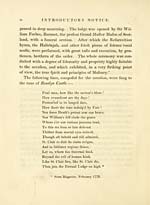Genealogie of the Sainteclaires of Rosslyn
(19) Page v
Download files
Complete book:
Individual page:
Thumbnail gallery: Grid view | List view

INTRODUCTORY NOTICE. v
The high antiquity affigned to the alleged heritable convey-
ance of the office of Grand Mafon in favour of the anceftor of
the laftRofslyn, appears fomewhat queftionable, and there is cer-
tainly nothing like legal, or even moral evidence to warrant a be-
lief that any grant ever was conferred by King James II. It is
faid, " In the reign of James II, the office of Grand Mafter was
granted by the Crown to William St. Clair, Earl of Orkney and
Caithnefs, and founder of the much-admired Chapel of Rofslyn ;
and from his attention to the mterefts of the order, the office
was made hereditary in his family. The Barons of Rofslyn held
their principal annual meetings at Kilwinning, and regular
lodges were formed in different parts of the kingdom, by char-
ters of erection granted by the Kilwinning Lodge.
" When James VI. afcended the Englilh throne, he neglected
his right of nominating the office-bearers of the fraternity ; and
in confequence of this, the Scotifh mafons granted two charters
to the St. Clairs of Rofslyn, which exift in Hay's MS. in the Ad-
vocates' Library.
" In 1736, William St. Clair of Rofslyn having no children,
refigned into the hands of the Scotifh lodges the right of no-
minating their own Grand Mafter, and other office-bearers, —
an event which led to the formation of the Grand Lodges of
Scotland."*
If fuch an heritable office had ever been created by James
II, it muft, according to the ordinary rules of fucceffion,
have defcended to the elder branch of the Saintclair family.
* Brewster's Encyclopedia. — Masonry.
The high antiquity affigned to the alleged heritable convey-
ance of the office of Grand Mafon in favour of the anceftor of
the laftRofslyn, appears fomewhat queftionable, and there is cer-
tainly nothing like legal, or even moral evidence to warrant a be-
lief that any grant ever was conferred by King James II. It is
faid, " In the reign of James II, the office of Grand Mafter was
granted by the Crown to William St. Clair, Earl of Orkney and
Caithnefs, and founder of the much-admired Chapel of Rofslyn ;
and from his attention to the mterefts of the order, the office
was made hereditary in his family. The Barons of Rofslyn held
their principal annual meetings at Kilwinning, and regular
lodges were formed in different parts of the kingdom, by char-
ters of erection granted by the Kilwinning Lodge.
" When James VI. afcended the Englilh throne, he neglected
his right of nominating the office-bearers of the fraternity ; and
in confequence of this, the Scotifh mafons granted two charters
to the St. Clairs of Rofslyn, which exift in Hay's MS. in the Ad-
vocates' Library.
" In 1736, William St. Clair of Rofslyn having no children,
refigned into the hands of the Scotifh lodges the right of no-
minating their own Grand Mafter, and other office-bearers, —
an event which led to the formation of the Grand Lodges of
Scotland."*
If fuch an heritable office had ever been created by James
II, it muft, according to the ordinary rules of fucceffion,
have defcended to the elder branch of the Saintclair family.
* Brewster's Encyclopedia. — Masonry.
Set display mode to:
![]() Universal Viewer |
Universal Viewer | ![]() Mirador |
Large image | Transcription
Mirador |
Large image | Transcription
Images and transcriptions on this page, including medium image downloads, may be used under the Creative Commons Attribution 4.0 International Licence unless otherwise stated. ![]()
| Histories of Scottish families > Genealogie of the Sainteclaires of Rosslyn > (19) Page v |
|---|
| Permanent URL | https://digital.nls.uk/94822754 |
|---|
| Description | A selection of almost 400 printed items relating to the history of Scottish families, mostly dating from the 19th and early 20th centuries. Includes memoirs, genealogies and clan histories, with a few produced by emigrant families. The earliest family history goes back to AD 916. |
|---|

